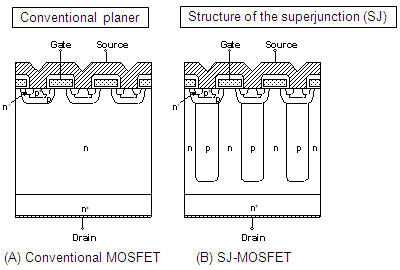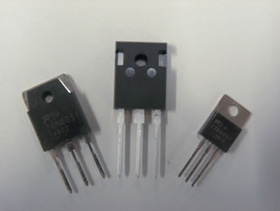News Release
Release of the Super J-MOS Series
December 22,2011
Fuji Electric Co., Ltd.
Fuji Electric Co., Ltd., announces today the release of its Super J-MOS series with industry-leading low on-resistance.
1. Objective
Amidst heightening concerns over the global environment, initiatives to become more environmentally friendly in the fields of IT and new energy, among others, are focusing attention on power semiconductors with efficient power conversion. In this context, demand exists for MOSFETs (metal-oxide-semiconductor field-effect transistor)—the principal devices used for power conversion in semiconductors—that improve energy efficiency to a greater extent than in the past. In response, Fuji Electric is releasing the Super J-MOS series featuring its newly developed superjunction (SJ) structure,* which achieves low on-resistance performance and significantly reduces energy loss.
With the release of the new series, Fuji Electric intends to contribute to the realization of a low-carbon society by improving power conversion efficiency and reducing power consumption in equipment.
2. Features
70% reduction*2 in on-resistance, thereby achieving industry-leading performance in low power loss
The latest switching loss reduction technology, enabling a 14% reduction*2 in total loss from the device
3. Specifications (for representative models)
4. Main applications
Information and communications equipment including internet servers, uninterruptible power supply systems, and broadcasting equipment
Photovoltaic power conditioners and other power conversion equipment for new energy field
-
Notes:
-
-
*1
-
An advantage of the SJ structure is its ability to significantly reduce resistance values by increasing the impurity concentration of N-type regions. This is achieved through replacing the drift layer of a conventional MOSFET with a series of alternating P-type and N-type regions. In a conventional MOSFET’s planer structure, keeping the on-resistance below a constant value was not possible, as breakdown voltage was maintained by means of extending the electrically insulated region (depletion layer) in the high-resistance N-type layer. By contrast, although the SJ structure reduces resistance of the N-type layer, breakdown voltage is maintained, as the fabrication of P-type regions in the N-type regions enables the depletion layer to be extended not only in a lengthwise direction but also in a widthwise direction. In this way, the SJ structure realizes low on-resistance to a greater extent than the theoretical limitations of the conventional planer structure.
-
*2
-
Compared to previous Fuji Electric products
Reference: the SJ MOSFET structure

Products in the Super J-MOS series

Product enquiries
Sales Department I, Sales Division III, Power Electronics Group, Sales Headquarters,
Fuji Electric Co., Ltd.
Telephone: 81-3-5435-7256
